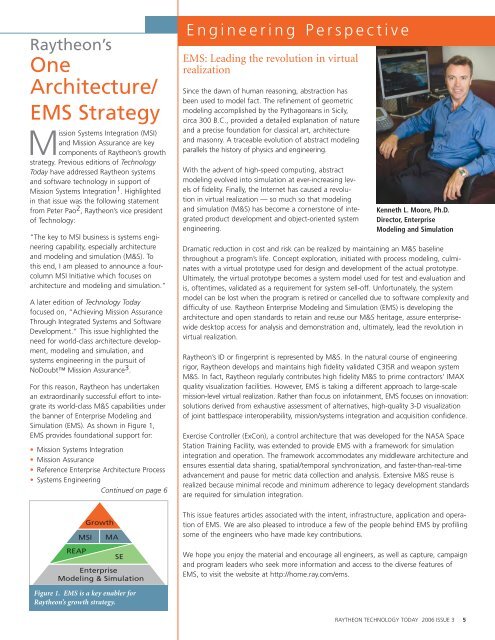Technology Today 2006 Issue 3 - Raytheon
Technology Today 2006 Issue 3 - Raytheon
Technology Today 2006 Issue 3 - Raytheon
Create successful ePaper yourself
Turn your PDF publications into a flip-book with our unique Google optimized e-Paper software.
<strong>Raytheon</strong>’s<br />
One<br />
Architecture/<br />
EMS Strategy<br />
Mission Systems Integration (MSI)<br />
and Mission Assurance are key<br />
components of <strong>Raytheon</strong>’s growth<br />
strategy. Previous editions of <strong>Technology</strong><br />
<strong>Today</strong> have addressed <strong>Raytheon</strong> systems<br />
and software technology in support of<br />
Mission Systems Integration 1 . Highlighted<br />
in that issue was the following statement<br />
from Peter Pao 2 , <strong>Raytheon</strong>’s vice president<br />
of <strong>Technology</strong>:<br />
“The key to MSI business is systems engineering<br />
capability, especially architecture<br />
and modeling and simulation (M&S). To<br />
this end, I am pleased to announce a fourcolumn<br />
MSI Initiative which focuses on<br />
architecture and modeling and simulation.”<br />
A later edition of <strong>Technology</strong> <strong>Today</strong><br />
focused on, “Achieving Mission Assurance<br />
Through Integrated Systems and Software<br />
Development.” This issue highlighted the<br />
need for world-class architecture development,<br />
modeling and simulation, and<br />
systems engineering in the pursuit of<br />
NoDoubt Mission Assurance 3 .<br />
For this reason, <strong>Raytheon</strong> has undertaken<br />
an extraordinarily successful effort to integrate<br />
its world-class M&S capabilities under<br />
the banner of Enterprise Modeling and<br />
Simulation (EMS). As shown in Figure 1,<br />
EMS provides foundational support for:<br />
Mission Systems Integration<br />
Mission Assurance<br />
Reference Enterprise Architecture Process<br />
Systems Engineering<br />
Continued on page 6<br />
Growth<br />
MSI MA<br />
REAP<br />
SE<br />
Enterprise<br />
Modeling & Simulation<br />
Figure 1. EMS is a key enabler for<br />
<strong>Raytheon</strong>’s growth strategy.<br />
Engineering Perspective<br />
EMS: Leading the revolution in virtual<br />
realization<br />
Since the dawn of human reasoning, abstraction has<br />
been used to model fact. The refinement of geometric<br />
modeling accomplished by the Pythagoreans in Sicily,<br />
circa 300 B.C., provided a detailed explanation of nature<br />
and a precise foundation for classical art, architecture<br />
and masonry. A traceable evolution of abstract modeling<br />
parallels the history of physics and engineering.<br />
With the advent of high-speed computing, abstract<br />
modeling evolved into simulation at ever-increasing levels<br />
of fidelity. Finally, the Internet has caused a revolution<br />
in virtual realization — so much so that modeling<br />
and simulation (M&S) has become a cornerstone of integrated<br />
product development and object-oriented system<br />
engineering.<br />
Kenneth L. Moore, Ph.D.<br />
Director, Enterprise<br />
Modeling and Simulation<br />
Dramatic reduction in cost and risk can be realized by maintaining an M&S baseline<br />
throughout a program’s life. Concept exploration, initiated with process modeling, culminates<br />
with a virtual prototype used for design and development of the actual prototype.<br />
Ultimately, the virtual prototype becomes a system model used for test and evaluation and<br />
is, oftentimes, validated as a requirement for system sell-off. Unfortunately, the system<br />
model can be lost when the program is retired or cancelled due to software complexity and<br />
difficulty of use. <strong>Raytheon</strong> Enterprise Modeling and Simulation (EMS) is developing the<br />
architecture and open standards to retain and reuse our M&S heritage, assure enterprisewide<br />
desktop access for analysis and demonstration and, ultimately, lead the revolution in<br />
virtual realization.<br />
<strong>Raytheon</strong>’s ID or fingerprint is represented by M&S. In the natural course of engineering<br />
rigor, <strong>Raytheon</strong> develops and maintains high fidelity validated C3ISR and weapon system<br />
M&S. In fact, <strong>Raytheon</strong> regularly contributes high fidelity M&S to prime contractors’ IMAX<br />
quality visualization facilities. However, EMS is taking a different approach to large-scale<br />
mission-level virtual realization. Rather than focus on infotainment, EMS focuses on innovation:<br />
solutions derived from exhaustive assessment of alternatives, high-quality 3-D visualization<br />
of joint battlespace interoperability, mission/systems integration and acquisition confidence.<br />
Exercise Controller (ExCon), a control architecture that was developed for the NASA Space<br />
Station Training Facility, was extended to provide EMS with a framework for simulation<br />
integration and operation. The framework accommodates any middleware architecture and<br />
ensures essential data sharing, spatial/temporal synchronization, and faster-than-real-time<br />
advancement and pause for metric data collection and analysis. Extensive M&S reuse is<br />
realized because minimal recode and minimum adherence to legacy development standards<br />
are required for simulation integration.<br />
This issue features articles associated with the intent, infrastructure, application and operation<br />
of EMS. We are also pleased to introduce a few of the people behind EMS by profiling<br />
some of the engineers who have made key contributions.<br />
We hope you enjoy the material and encourage all engineers, as well as capture, campaign<br />
and program leaders who seek more information and access to the diverse features of<br />
EMS, to visit the website at http://home.ray.com/ems.<br />
RAYTHEON TECHNOLOGY TODAY <strong>2006</strong> ISSUE 3 5

















